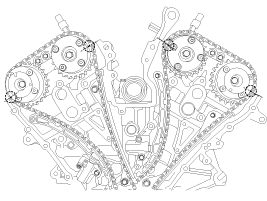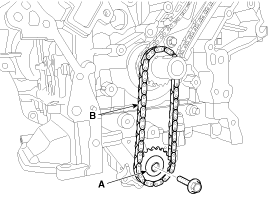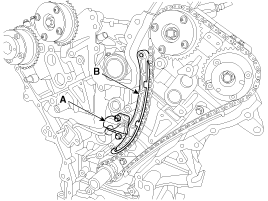Kia Cadenza: Timing System / Timing Chain Repair procedures
Kia Cadenza YG 2016-2025 Service Manual / Engine Mechanical System / Timing System / Timing Chain Repair procedures
| Removal |
| 1. |
Set No.1 cylinder to TDC/compression.
|
| 2. |
Remove the timing chain cover.
(Refer to Timing System - "Timing Chain Cover")
|
| 3. |
Remove the oil pump chain cover (A).
|
| 4. |
Remove the oil pump chain tensioner assembly (A).
|
| 5. |
Release the ratchet by pulling the link down using a thin
rod. Compress the piston and then insert a stopper pin into the hole on
the ratchet to hold the compressed piston.
|
| 6. |
Remove the RH timing chain cam to cam guide (A).
|
| 7. |
Remove the RH timing chain auto tensioner (A) and the RH timing chain tensioner arm (B).
|
| 8. |
Remove the RH timing chain guide (A).
|
| 9. |
Remove the RH timing chain (A).
|
| 10. |
Remove the crankshaft sprocket (A) ( RH camshaft drive).
|
| 11. |
Remove the oil pump chain sprocket (A) and oil pump chain (B).
|
| 12. |
Remove the crankshaft sprocket (A) (Oil pump drive).
|
| 13. |
Release the ratchet by pulling the link down using a thin
rod. Compress the piston and then insert a stopper pin into the hole on
the ratchet to hold the compressed piston.
|
| 14. |
Remove the LH timing chain cam to cam guide (A).
|
| 15. |
Remove the LH timing chain auto tensioner (A) and LH timing chain tensioner arm (B).
|
| 16. |
Remove the LH timing chain guide (A).
|
| 17. |
Remove the LH timing chain (A).
|
| 18. |
Remove the crankshaft sprocket (A). (LH camshaft drive).
|
| 19. |
Remove the tensioner adapter assembly (A).
|
| Inspection |
Sprockets, Chain Tensioner, Chain Guide, Chain Tensioner Arm
| 1. |
Check the camshaft sprocket and crankshaft sprocket for abnormal wear, cracks, or damage. Replace as necessary. |
| 2. |
Inspect the tensioner arm and chain guide for abnormal wear, cracks, or damage. Replace as necessary. |
| 3. |
Check that the tensioner piston moves smoothly when the ratchet pawl is released with thin rod. |
| Installation |
| 1. |
Install the jack to the edge of upper oil pan to support the engine.
|
| 2. |
The key (A) of crankshaft should be aligned with the timing
mark (B) of block. As a result of this, the piston of No.1 cylinder is
placed at the top dead center on compression stroke.
|
| 3. |
Install the tensioner adapter assembly (A).
|
| 4. |
Install the crankshaft sprocket (A). (LH camshaft drive).
|
| 5. |
Install the LH timing chain (A).
|
| 6. |
Install the LH timing chain guide (A).
|
| 7. |
Install the LH timing chain auto tensioner (A) and LH timing chain tensioner arm (B).
|
| 8. |
Install the LH timing chain cam to cam guide (A).
|
| 9. |
Pull out the pins of LH timing chain auto tensioner.
|
| 10. |
Install the crankshaft sprocket (A) (Oil pump drive).
|
| 11. |
Install the oil pump chain sprocket (A) and oil pump chain (B).
|
| 12. |
Install the RH timing chain (A).
|
| 13. |
Install the RH timing chain guide (A).
|
| 14. |
Install the RH timing chain auto tensioner (A) and the RH timing chain tensioner arm (B).
|
| 15. |
Install the RH timing chain cam to cam guide (A).
|
| 16. |
Pull out the pins of RH timing chain auto tensioner.
|
| 17. |
Install the oil pump chain tensioner assembly (A).
|
| 18. |
Install the oil pump chain cover (A).
|
| 19. |
After rotating the crankshaft 2 revolutions in regular direction (clockwise viewed from front), confirm the timing mark.
|
| 20. |
Install the timing chain cover.
(Refer to Timing System - "Timing Chain Cover") |
| 21. |
Install the other parts reverse order of removal.
|
 Timing Chain Components and Components Location
Timing Chain Components and Components Location
Components
1. Oil pump chain cover2. Oil pump sprocket3. Oil pump chain 4. Oil pump tensioner assembly5. Crankshaft oil pump sprocket6. Crankshaft RH chain sprocket7. RH Timing chain auto tension ...
Other information:
Kia Cadenza YG 2016-2025 Service Manual: Components and Components Location
Components Location [Vehicle Components] 1. Automatic transaxle2. Transaxle Control Module (TCM)3. Shift lever4. Date Linke Connector (DLC) [Transaxle Components] 1. Input speed sensor2. Output speed sensor3. Solenoid valve connect4. Oil Temperature Sensor (OTS)5. Valve body assembly6. S ...
Kia Cadenza YG 2016-2025 Service Manual: Catalytic Converter Repair procedures
Removal [Catalytic Converter (WCC)] 1. Remove the exhaust manifold. (Refer to Engine Mechanical System - "Exhaust Manifold") [Catalytic Converter (UCC)] 1. Remove the Center Muffler. (Refer to Engine Mechanical System - "Center Muffler") Installation 1. Install in the reve ...
Copyright © www.kcadenzavg.com 2017-2025





























